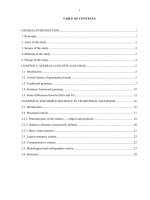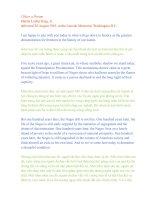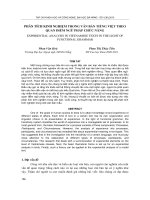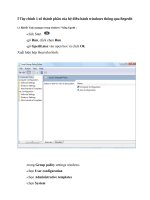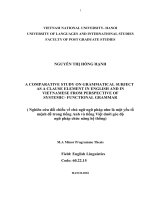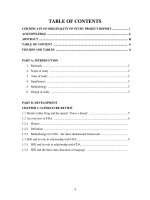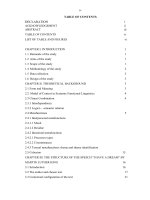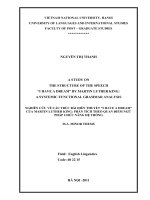nghiên cứu về cấu trúc bài diễn thuyết “ i have a dream” của martin luther king phân tích theo quan điểm ngữ pháp chức năng hệ thống
Bạn đang xem bản rút gọn của tài liệu. Xem và tải ngay bản đầy đủ của tài liệu tại đây (817.21 KB, 58 trang )
iv
TABLE OF CONTENTS
DECLARATION i
ACKNOWLEDGEMENT ii
ABSTRACT iii
TABLE OF CONTENTS iv
LIST OF TABLE AND FIGURES vi
CHAPTER I: INTRODUCTION 1
1.1 Rationale of the study 1
1.2 Aims of the study 1
1.3 Scope of the study 1
1.4 Methodology of the study 2
1.5 Data collection 2
1.6 Design of the study 3
CHAPTER II: THEORETICAL BACKGROUND 3
2.1 Form and Meaning 3
2.2. Model of Context in Systemic Functional Linguistics 4
2.3 Clause Combination 4
2.3.1 Interdependency
2.3.2 Logico – semantic relation
2.4 Metafunctions 5
2.4.1 Interpersonal metafunctions
2.4.1.1 Mood
2.4.1.2 Residue
2.4.2 Ideational metafunctions
2.4.2.1 Processes types
2.4.2.2 Circumstances
2.4.3 Textual metafunctions: theme and rheme identification
2.5 Cohesion 15
CHAPTER III: THE STRUCTURE OF THE SPEECH “I HAVE A DREAM” BY
MARTIN LUTHER KING 16
3.1 Introduction 16
3.2 The author and chosen text 17
3.3 Contextual configuration of the text 21
v
3.4 Clause and Clause complex analysis 21
3.5 The Analysis of the text in terms of Transitivity, Mood and Theme 23
3.6 The Transitivity pattern of the text 32
3.7 The Mood pattern of the text 35
3.8 The Thematic pattern of the text 35
3.9 The Cohesion of the text 36
3.9.1 Grammatical Cohesion
3.9.2 Lexical Cohesion
CHAPTER IV: CONCLUSION 43
4.1 Recapitulation 43
4.2 Implications of the study 44
4.3 Suggestions for further study 44
REFERENCES 45
APPENDIX I
vi
LIST OF TABLE AND FIGURES
TABLES
Table 2.1 Overview of the process types
Table 2.2 Circumstantial Elements
FIGURES
Figure 2.1 Basic speech roles
Figure 2.2 The principal types of process
1
CHAPTER I
INTRODUCTION
1. Rationale of the study
Language, no matter how it is analyzed and assessed, is still produced due to human
needs. Therefore, its structure and components are functional with respect to those needs
(M.A.K Halliday, 1994). This leads to the fact that no language item is separate, each
piece of it is evolved to the functions which are decided by humans in communication,
and grammar is not an exception.
However, it seems that the process of teaching and learning the language tends to make a
clear distinction between grammar and other linguistics areas, as in structuralism‟s
perspectives. Functionalists, on the other hand, hold the belief that “Grammar should be
seen as facilitating communication in all modes, not as an isolated area of study” (G.
Lock, 1996).
As having the experience of drilling with a number of grammar exercises in schooling as
well as being the teacher for many grammar classes, I am deeply interested in improving
the language proficiency along with the structure accuracy for my students. That is the
reason why I have developed a great attention to Functional Grammar (or FG for short).
The further I am absorbed in this linguistic aspect, the stronger my notion of its
applications in language teaching and learning becomes.
Hence, I decided to conduct a study on the structure and meaning of the speech “I have a
dream” by Martin Luther King - a systemic functional grammar analysis based on
Halliday‟s functional grammar as the theoretical framework.
1.2 Aims of the study
In carrying out the research, the writer aims to:
Illustrate the key concepts in FG
Analyze the structure and meaning of the speech “ I have a dream” by Martin
Luther King
Suggest some further implications for language teaching and learning
2
1.3 Scope of the study
It would be impossible for the researcher to cover the issues of FG. However, some
important notions such as linguistic system, metafunctions and cohesion which are
closely related to the study will be examined in detail.
1.4 Methodology of the study
The structure and meaning of the speech will be focused in the study, therefore the
methodologies applied are:
Descriptive which is used for illustrating the crucial matters of FG
Analysis which is used for studying the speech
1.5 Data Collection
A various number of examples and illustrations have been extracted from functional
grammar works by well known linguistics such as M.A.K Halliday (1985/1994),
Thompson (1994), G.Lock (1996), Van. Hoang Van (2006)….
The content of the speech “I have a dream” is retrieved from the official and popular
website www.americanrhetoric.com .
1.6 Design of the study
There are four main chapters in this minor thesis
Chapter I: Introduction , gives an overview of the rationale, aims, scope,
methodology and design of the study
Chapter II: Theoretical Background, illustrates the theoretical background for
the main concepts in FG
Chapter III: The analysis of the speech “I have a dream”
Chapter IV: Conclusion summarizes the outcome of the research and suggests
some further implications for language teaching and learning.
3
CHAPTER II
THEORETICAL BACKGROUND
This section provides theoretical orientations for the study. In the first place, (i) Form and
Meaning as well as (ii) Model of context in Systemic Functional Linguistics (SFL) will
be concerned. After that, there will be an overview of (iii) Clause Combination, (iv)
Metafunctions, and (v) Cohesion. In addition, the English language is going to be used as
illustration.
2.1 Form and Meaning
Both approaches, through Form and Meaning, try to find out the answer to the question
of language features. According to Horrocks (1987), as cited in Thompson (1996), the
most fully promoted theory of the Form approach, known as Transformative Generative
(TG), is proposed by Noam Chomsky and his followers. These linguists intend to explain
the language structure in the way it is. At the same time, the rules for grammatically
correct or incorrect usage are set out as the guide for language learners. A sentence or
utterance is said to be wrong or right is due to its obedience to the TG laws of grammar.
On the other hand, Halliday (1994) views language not as a system of rules but “a system
of meanings”. He suggests the most practical approach to the grammatical construction
should be meaning – centered. This theory is also approved by Thompson, who points out
that “the formative influences of the uses to which language is put” (1996:6) should be
considered as important as the structure. In other words, the communicative purposes and
choices, or the sentence – utterance meaning plays another indispensable part in
linguistics. That is the reason why Systemic Functional Linguistics takes language to its
functions through meaning not just formation.
2.2. Model of Context in Systemic Functional Linguistics
SFL characterizes context as the social – cultural situations related directly to the
language usage. According to Halliday (1976), the conceptual framework for illustrating
the context in which exchanging information is the focus includes three dimensions: (i)
the on going social activity, (ii) the role of relationship involved, and (iii) the symbolic or
rhetorical channels, which he names as Field, Tenor, and Mode. They can be explained
briefly as follows:
4
(i) Field of Discourse: refers to the subject matter, what is happening, where,
when and why it happens …
(ii) Tenor of Discourse: deals with the social relation between participants as well
as the influence of this relation on linguistic system and exchange.
(iii) Mode of Discourse: describes the way the language is being used in
communication including the medium and rhetorical mode.
In brief, the three dimensions of context model are also the working hypothesis of
metafunctions. Halliday figures out that the Fields determine experiential meaning, Tenor
represents interpersonal meaning, and Mode corresponds to textual meaning.
2.3 Clause Combination
The relationship between clauses can be interpreted as “one of modification” (Halliday,
1994). As a result, the idea of modification will enable systematic substitute into two
dimensions: (i) interdependency and (ii) Logico- semantic relation.
2.3.1 Interdependency
This dimension illustrates the relation of modifying, where one element modifies or is
modified by other elements in the clause. Therefore, the relation is dependent or equal
due to the modification. If it is unequal with at least one dominant factor, the relationship
is named as Hypotaxis. On the other hand, if there is equality among elements, it is
known as Parataxis.
Hypotaxis: the relation between a dependent element and its dominant, the
element that controls it. Hypotaxis structures will be described by the
Greek letter notation (α, β,γ…) and a single slash.
Parataxis: the equal relation between elements. For paratactic structures,
numerical notation ( 1, 2, 3…) and double slashes will be used for
illustration.
In fact, a typical complex clause is a combination of hypotactic and paratactic sequences,
so it will be impractical if they are separated in analysis. For instance, the following
complex clause can be viewed as:
|||I would / if I could, || but I can’t|||
1α 1β 2
(Halliday, 1994: 218)
5
2.3.2 Logico – semantic relation
This second dimension of clause combination explains the nexus between clauses in a
variety of logico-semantic relation. However, the two most fundamental relationships are
(i) Expansion and (ii) Projection.
(i) Expansion: the secondary clause expands the primary one by elaborating, extending or
enhancing it.
Elaborating (i.e.): restating in other words, making the clause clearer, commenting
and giving illustration.
Extending (and, or): adding new information, providing alternative…
Enhancing (so, yet, then) : giving circumstantial characteristics of time, place,
cause, or condition
(ii) Projection: the second clause is projected by the primary clause as a locution or an
idea.
Locution (say) : a construction of wording
Idea (think) : a construction of meaning
2.4 Metafunctions
Halliday (1994: 35) refers to the term metafunctions not simply as the characteristics of
the clause but the throughout meaning in the clause. Metafunctions, in his point of view,
are divided into three broad functions of language, known as interpersonal, ideational and
textual metafunctions.
2.4.1 Interpersonal metafunctions
Interpersonal metafunctions is constructed on the idea that clause can act as an exchange.
The communicative exchange purpose may be ordering, apologizing, confirming,
inviting, rejecting, evaluating…However, the most basic ones are demanding and giving
the language commodity, or information and “goods and services” (Halliday, 1994).
Thompson (1996:40) figures out the basic speech roles associated with specific
grammatical structures.
6
Role
in exchange
Commodity
exchanged
Goods & services
Information
Giving
Offer
I‟ll show you the way.
Statement
We‟re nearly there.
Demanding
Command
Give me your hand.
Question
Is this the place?
Figure 2.1. Basic Speech Roles
In carrying the exchange of interactive relation, a clause can be seen as consisting of two
components: Mood and Residue.
2.4.1.1 Mood
In order to figure the structure of Mood, Halliday (1994) takes the responses in the
following example as an illustration
The man’s given away that teapot, hasn’t he?
Oh, has he?
Yes, he has.
No, he hasn’t.
I wish he had.
He hasn’t, but he will.
Will he?
He might.
The parts, which are “tossed back and forward” to keep the exchange going, are called
Mood, including two elements: (i) Subject and (ii) Finite. On the other hand, the thrown –
away parts (that teapot, hasn’t he?) which are not of great essence to carry the argument
are named Residue.
Therefore, when clause is viewed as an exchange, it can be analyzed as following:
I
Am
Writing a letter for her.
Subject
Finite
Residue
Mood
(i) The Subject is a similar term from traditional grammar. It supplies the rest of what it
takes to form a proposition, something by reference to which the proposition can be
affirmed or denied.
7
(ii) Finite can be used to make reference to time of speaking (temporal operator) or to the
judgment of speaking (modal operator). Sometimes, it is obvious to find out Finite as in
the cases when auxiliary or modal verbs are separated.
Did you invite her to the party?
I can go with you.
However, finite can be mixed with lexical verbs in simple present and simple past tense
The sun sets in the West.
I got the test result yesterday.
2.4.1.2 Residue
The rest of the clause excluding Mood is called Residue. This part consists of three other
factors: (i) Predicator, (ii) Complement, and (iii) Adjuncts.
(i) Predicator: is expressed by the verbal group, it is also an indispensable section of any
clause. The predicator presents the action, happening state…in which the subject is
involved.
(ii) Complement: is realized by a nominal group. The orders of complement and subject
will have an influence on thematic purposes of the clause.
(iii) Adjuncts: is performed by an adverbial group or a prepositional phrase.
In short, the interpersonal metafunctions can be illustrated once again as in Thompson‟s
following sample (1996):
In the following
day
he
did not
go
out
early
Adjunct
Subject
Finite
Predicator
Adjunct
Adjunct
Residue
Mood
Residue
2.4.2 Ideational metafunctions
This division of metafunctions represents the idea that language serves for the expression
of content, in other words, the speaker‟s background knowledge and experience,
including his own awareness. The clause plays a central role as representation including
the principles, which are made of processes. Meanwhile the clause is also a mode of
reflection achieved through the grammatical system namely transitivity consisting of a set
of process types.
8
The process types, in general, express the “goings-on, happening, doing, sensing,
meaning, being and becoming” (Halliday, 1994) which are going to be analysed further.
2.4.2.1 Processes types, participants and circumstances
The framework of a process involves three main factors:
(i) The process itself: realized typically by verbal groups
(ii) Participants in the process: realized typically by nominal groups
(iii)Circumstances associated with the process: realized typically by adverbial group
or prepositional phrase.
The concepts of process, participants and circumstances are semantic categories, which
provide the linguistic structure of the events in reality. Each type of process contributes to
the construction of English grammar and there are specific kinds of participants
associated with it in particular circumstances.
Material process
This type of process carries out the meaning of actions or some entity “does” something,
which may have some influences on other entity. The “doer” of the action is called Actor.
In many cases, the actions may be referred as affecting to the second participant in the
process, this one is known as Goal. The Actor and Goal can be either human or
inanimate.
The man
painted
the house
Actor
Material process
Goal
The dog
barked at
the man
Actor
Material process
Goal
Furthermore, material processes are not necessarily tangible or physical activity. They
might be intangible actions or happenings as Halliday mentioned in the following
examples.
The mayor
resigned.
Actor
Material process
The mayor
dissolved
the committee
Actor
Material process
Goal
9
When there is the existence of more than two participants, the one that benefits from the
process is called Receiver.
I
gave
him
a book
Actor
Material process
Goal
Receiver
Mental process
This type of process expresses the processes of feeling, liking and seeing. The participant
who is the conscious being that is feeling, liking and seeing is named as Senser. The
sensed or felt, liked and seen participant is called the Phenomenon. This is not simply a
thing but also a fact. A thing can be felt, liked and seen. A fact, not the fact of some
situation, is the one, which can be sensed as in the following examples.
Furthermore, mental process is divided into three sub – types:
Perception: seeing, hearing…
Affection: liking, fearing…
Cognition: thinking, knowing, and understanding…
I
can‟t see
you.
Senser
Mental process: Perception
Phenomenon
They
really loved
the city.
Senser
Mental process: Affection
Phenomenon
The students
understood
the problem
Senser
Mental process:Cognition
Phenomenon
Relational processes
The third type of processes is relational, something is being said to be something else.
There are three main kinds of relational processes:
(i) Intensive :X is A
(ii) Circumstantial: X is at A (refer to location)
(iii)Possessive : X has A
The three types come to two modes:
Attribute: A is an attribute of X
Identifying: A is the identity of X
10
Halliday offer the principal types of process as following:
Attributive
Identifying
Intensive
Sarah is wise
The leader is Tom;
Tom is the leader.
Circumstantial
The fair is on a Tuesday.
Tomorrow is the 10th.
The 10th is tomorrow.
Possessive
Peter has a piano
The piano is Peter‟s.
Peter‟s is the piano.
Figure 2. 2. The principal types of process
In Atributive mode, one participant is known as Carrier and the quality to represent the
possessive relation of Carrier is referred to as Attributive.
The man
is
clever
Carrier
Relational Process
Attribute
On the other hand, in Identifying mode, there is a clear distinction between the
identifying and identified participants. This pair is termed as Identifier/ Identified and
Token/ Value.
Tom
is
the leader
Identified/ Token
Relational process
Identifier/ Value
The possessive relationship can be referred as Possessor and Possessed.
Peter
has
a piano
Possessor
Relational process
Possessed
Behavioral processes
This type of process shares the characteristics of mental and material process. It
illustrates the physiological and psychological behaviors such as cough, smile, dream
The participant who behaves is the Behaver and there are five kinds of this process as
Halliday suggests:
1. Processes of consciousness as form of behavior: look, watch, stare
2. Verbal processes as behavior: chatter, grumble, talk
3. Physiological processes manifesting states of consciousness: cry, laugh
4. Other physiological processes: breathe, faint, sleep
5. Bodily postures and pastimes: sing, dance, lie
11
Normally, there is one participant in behavioral process:
He
cried
in silence
Behaver
Behavioral process
Circumstances
However, the second participant, which is repeated, is called Range in behavioral
process:
She
laughed
an embarrassed laugh
Behaver
Behavioral process
Range
When the second participant is not a repetition, it becomes Phenomenon:
I
smell
the rose
Behaver
Behavioral process
Phenomenon
Verbal processes
This is the process of saying, not simply the action of speaking out some notions but also
the symbolic exchange of meaning. Therefore, in I told you or The guide book tells
everything, both “I” and “The guide book” is the participant which is named Sayer.
The verbal process includes not only Sayer but Receiver (the one to whom the process is
aimed), Verbiage (content of what is said or name of the saying), and Target (the thing
that is targeted by the process) as well.
He
told
me
the truth
Sayer
Verbal process
Receiver
verbiage
The relationship of quoting or reporting is also demonstrated in this type of process.
She
said
“give me that”
Sayer
Verbal process
Reported
She
said
that she would go away
Sayer
Verbal process
Quoted
Existential Processes
This illustrates that something exists or happens. Normally, the word There will appear in
the process as the Subject without representational function. Existential process typically
involves the verb BE and other verbs to express the existence or happening such as exist,
remain, arise, occur
12
The object or event which is being said to be existent is known as Existent. It can be an
entity or an event that takes place.
There
is
a storm
Existential process
Existent : event
There
is
someone
out side
Existential process
Existent: entity
Circumstance
In short, the processes types and participant roles have been covered briefly. The
following table which is extracted from Halliday (1994:143) provides an overview of the
process types, their category meaning and participant roles
Process type
Category meaning
Participants
Material:
Action
Event
Doing
Doing
Happening
Actor, Goal, Receiver
Behavioral
Behaving
Behaver
Mental:
Perception
Affection
Cognition
Sensing
Seeing
Liking
Thinking
Senser, phenomenon
Verbal
Saying
Sayer, target
Relational:
Attribution
Identification
Being
Attributing
Identifying
Carrier, attribute
Identified/identifier;
Token/Value
Existential
Existing
Existent
Table 2.1. Overview of the process types
2.4.2.2 Circumstantial element
Circumstances may occur in the process with little or no restriction. They express the
notion of “When, where, how and why” the process takes place. Circumstantial factors
can be adverbial group or prepositional phrases.
13
Halliday (1994: 151) introduces a “fairly arbitrary list” of nine main circumstantial
elements:
Type
Specific categories
Example
1
Extent
Distance, duration
Go for 10 miles
Occurs every four years
2
Location
Place, time
At the party
At night
3
Manner
Means, quality,
comparison
I was hit with a stick
He sings loudly
She is like a princess
4
Cause
Reason, purpose, behalf
Because of his illness
For the sake of us
On behalf of
5
Contingency
Condition, concession,
default
In case of
In spite of
In the absence of
6
Accompaniment
Comitation, addition
He came with me.
Jane came as well as me
7
Role
Guise, product
I talked as a representative
She is turning into another
person
8
Matter
She is upset about her son.
9
Angle
According to the professor
Table 2.2 Circumstantial Elements
2.4.3 Textual metafunctions: theme and rheme identification
The metafunctions which give the clause the characteristics of a message is the Thematic
structure. In any clause, there is one element, which “serves as the point of departure”
namely Theme and the remainder of the clause, which develops Theme in order to
complete the message of the clause, is known as Rheme.
14
As “the starting – point of the message”, theme is commonly supposed to be at the
beginning rather than the end of the clause. Theme can be a nominal group, an adverbial
group or a prepositional phrase.
My father
is a mechanic.
Theme
Rheme
Long ago,
I lived in this village.
Theme
Rheme
In silence,
he got into the house.
Theme
Rheme
When Theme stands at the first place as a Subject of the clause, it is unmarked due to the
obvious role it is supposed to play. On the other hand, any themes other than the Subject
are referred to as marked theme, which is not common for theme as in the following
examples:
I
was there
Unmarked theme
Rheme
In 2000,
they moved to this area.
Marked theme
rheme
Theme can be single with only one constituent or multiple with further internal structure.
Theme can also be classified into topical (if combined with experiential factors), textual
(relevant meaning to discourse) and interpersonal (referring to speakers and listeners
interaction).
In short, the thematic structure in which Theme is the prominent element can be analyzed
to “gain an insight into its (the text) texture and understand how the writer made clear to
us the nature of his underlying concerns.” (Halliday, 1994: 67)
15
2.5 Cohesion
2.5.1 The concept of cohesion
According to Nguyen Hoa (2000), “cohesion refers to the formal relationship that causes
texts to cohere or stick together”. It is a wide range of semantic relationships conveyed
through clauses.
In analyzing text and its character, the notions of cohesion and coherence may cause
some confusing matters. However, Thompson (1996) figures out the main difference
between cohesion and coherence. He supposes that cohesion involves linguistic devices
and therefore it serves as “a textual phenomenon”. On the other hand, coherence works as
“a mental phenomenon” and cannot be achieved and identified as clearly as cohesion.
Due to the time limitation of the study, the issue of coherence will be eliminated while
further analysis will be for the more achievable process, the cohesion of the text.
Cohesion is expressed not only through grammatical cohesion including reference,
ellipsis, substitution, conjunction but also through lexical cohesion consisting of
repetition, synonym, and collocation. The analysis of the speech “I have a dream” by
Martin Luther King is supposed to be related to only some of the cohesion issues, which
are going to be dealt with in the following part.
2.5.2 Grammatical cohesion
2.5.2.1 Reference
Reference is about the lexical relationship in and out of the clause and it can be classified
into five main sub-types:
Anaphoric reference: which directs listeners or readers to refer “backwards” to
the preceding text to get a comprehensive understanding of the discourse.
e.g.: One hundred years later, the Negro is still languished in the corners of
American society and finds himself an exile in his own land.
Anaphoric reference
16
Cataphoric reference: This refers “forwards” the clause so as to specify the
reference meaning.
e.g.: As she arrived home, Janet noticed that the door was open.
Cataphoric reference
Exophoric reference: refers “outwards” the clause to some participants in the
previous part.
e.g.: The man turned out to be a thief.
Exophoric reference
Personal reference: is the reference to the category of human participants, using
pronouns.
e.g.: I and my mother are at the market. We want to buy some vegetables.
Personal reference
Comparative reference: for the purpose of illustrating comparison, similarities or
identities, comparative reference are expressions such as the same, similar to,
more than, the most, as good as…
e.g.: She cooks much better than her mum.
Comparative reference
2.5.2.2 Conjunction
The logico-semantic relations of clause combination including expansion and projection
create a variety of conjunctions. A wide range of meanings is conveyed by a conjunctive
Adjunct (an adverbial group or prepositional phrase) “within the domains of elaboration,
extension and enhancement” (Halliday, 1994:324)
Elaboration
Apposition: the restatement or represented of some factor
(i) Expository: in other words, that is to say, I mean…
(ii) Exemplifying: for example, for instance, to illustrate…
Clarification: summary and clearer reinstatement for the discourse purposes
(i) Corrective: rather than, at least, to be more specific…
17
(ii) Distractive: by the way, incidentally…
(iii) Dismissive: in any case, anyway, leaving that aside…
(iv) Particularizing: in particular, especially…
(v) Resumptive: to resume, as I was saying…
(vi) Summative: in short, to sum up, in brief…
(vii) Verifactive: actually, as a matter of fact, in fact…
Extension
Addition:
(i) Positive: and, also, moreover, in addition…
(ii) Negative: nor
Adversative: but, yet, on the other hand, however…
Variation:
(i) Replacive: on the contrary, instead of
(ii) Subtractive: apart from that, except for that …
(iii) Alternative: alternatively
Enhancement
Spatio – temporal: The spatial relations serve as “text-creating cohesive devices”
(i) Simple: following (then, next, afterwards…), simultaneous (just
then, at the same time…), preceding (before that, previously…)…
(ii) Complex: immediate (at once, imediately…), interrupted (soon,
after a while…), repetitive (next time, on another occasion…)…
(iii) Simple internal: (next, secondly…), simultaneous (at this point,
here…), preceding (up to now…)…
Manner: cohesion is created by manner conjunctives through comparison and
reference to means.
(i) Comparison: positive (likewise, similarly…) or negative (in a
different way)
(ii) Means: thus, thereby, by such means…
Causal – conditional: the causal expressions can be in general or specific while
the conditionals can be positive, negative or concessive
18
(i) Causal expressions: general ( so, then, hence…); specific (as a
result)
(ii) Conditionals: positive (in that case), negative (if not) or concessive
(yet, still, through…)
Matter: with this type of conjunction, the cohesion refers to the matter which
happened previously.
(i) Positive: here, there, as to that…
(ii) Negative: in other respects, elsewhere…
Obviously, the various kinds of conjunction are not definite; they can overlap with one
another. For instance, the concessive (despite) overlaps with the adversative (conversely).
The above clarification, which is provided by Halliday (1994) “are those which have
been found most useful in the interpretation of texts”.
2.5.3 Lexical cohesion
The choice of lexical items can determine the discourse cohesion. Lexical cohesion
involves the employment of Repetition, Synonymy, Antonym and Collocation
Repetition
A lexical item, whether a simple word unit or a sentence structure can be repeated. Such
equivalence serves as a reference to the preceding events as the word Negro in the
following example.
e.g.: But one hundred years later, the Negro still is not free. One hundred years later,
the life of the Negro is still sadly crippled by the manacles of segregation and the
chains of discrimination
Synonymy
The use of synonyms as another means of lexical cohesion is also frequent to “avoid
unnecessary repetition” (Nguyen Hoa, 2000) as in the case of “Proclamation” and
“decree” in the speech “I have a dream”.
e.g.: Five score years ago, a great American, in whose symbolic shadow we stand
today, signed the Emancipation Proclamation. This momentous decree came as a
great beacon light of hope to millions of Negro …
19
Antonym
Antonyms are able to convey lexical cohesion effectively when the relationship between
the ideas in a clause is of great contrary. For instance, the “poverty” of the Negro
contrasts to the “prosperity” of the White to demonstrate the huge distance in living
standards of the two communities
e.g.: One hundred years later, the Negro lives on a lonely island of poverty in the midst
of a vast ocean of material prosperity.
Collocation
This means of lexical cohesion seems to be only dependent on particular associations
between items. Collocation is “one of the factors on which we build our expectations of
what is to come next” (Halliday, 1994) as in the following case; there is a collocation
bond between the bank and bankrupt.
e.g.: But we refuse to believe that the bank of justice is bankrupt.
In summary, this chapter has provided the theoretical background relevant for the
objectives of the study. The researcher has illustrated an overview of the notions of Form
and Meaning and the Context model in SFL. The Combination of clauses based on
interdependency and logico-semantic relation as well as the Metafunctions including
interpersonal metafunctions, ideational metafunctions and textual metafunctions have
been represented in a brief way. Finally, the idea of Cohesion and its major types as a
means of analyzing texts have also been introduced as the last fundamental concept
important for the study. In the next chapter, the speech “I have a dream” is going to be
investigated based on the systemic functional approach
20
CHAPTER III
THE STRUCTURE OF THE SPEECH “I HAVE A DREAM”
BY MARTIN LUTHER KING
3.1 Introduction
The title “speech” is supposed to be related to a spoken piece of language in use.
However, from systematic functional grammar, Halliday and Hasan (1975) indicated that
any passage, even spoken or written, of whatever length, that does form a unified
whole… can be considered “text”. Therefore, the title of the thesis “A study on the
structure of the speech”, in other words, refers to the analysis of the speech as text based
on functional linguistics.
In order to analyze the grammar and meaning of the text “I have a dream” by Martin
Luther King, the first step should be making a clear definition of the term “text”. The
word by itself is derived from the Latin word meaning “texture”, which is defined as „the
character of a piece of writing‟ by the Cambridge Advanced Learner’s Dictionary (2005).
However, according to linguists, “text” definition can be approached from at least two
main perspectives.
First of all, Cook (1989: 158), as cited in Alexander Täuschel (2004), claims that “Text is
a stretch of language interpreted formally, without context”. The Collins English
Dictionary tends to support Cook‟s ideas “Text is a body of printed or written word”
(1990). In general, he seems to separate the term “text” completely from “context”, which
may not make other linguists be in favour of.
On the other hand, the notion about “text” definition in systemic functional linguistics is
clarified as any united ideas expressed even in spoken or written can be named “text” as
Halliday and Hasan (1975) figure out. Sharing the same opinions, Brown and Yule
(1983) “use text as a technical term to refer to the verbal record a communicative act”.
They have a tendency to explore the context or communicative event in which text
occurs. This is also what Nunan (1993: 7-8) presents “I shall use the term text to refer to
any written record of a communicative event. The event itself involves oral language or
written language”.
The procedures and conventions used in the following analysis will be carried out basing
on the framework of M.A.K. Halliday and Hasan (1976): Cohesion in English; Halliday
21
and Hasan‟s (1985) Language, text and context: Aspect of Language in Social – Semiotic
Perspective and Halliday‟s (1994) An introduction to Functional Grammar.
3.2 The author and chosen text
Born on 15
th
January 1929 in Atlanta, Georgia, Martin Luther King was the son of a
Baptist minister and a schoolteacher. In 1944, he attended Morehouse College and then
continued his post graduate study at Crozer Religious Seminary and received his
doctorate in 1955. From that time until his death, King devoted his whole time and effort
to the protest against discrimination against the Negro in the United States. He was
awarded the Nobel Peace Prize in 1964, however, 4 years later he was assassinated in
Memphis, Tennessee.
The speech “I have a dream” was delivered to more than 200,000 people in 1963 at the
Lincoln Memorial, Washington D.C. The talk was King‟s prediction about a day of racial
equality for the Negro which would become reality in America. There are several
versions of the speech with minor differences. The content taken into consideration in
this paper is retrieved from the site , one of the most
popular sources for American public speeches.
3.3 Contextual configuration of the text
Based on the idea that we can make predictions about the content of context, Halliday
and Hasan (1989) develop a model for contextual analysis which includes three main
elements: Field, Tenor and Mode (See 2.2). The chosen text will be explored in that way.
1. Field:
A spoken text to express thoughts and opinions and then to ask for specific
actions.
Participants types: actors, sensers, carriers
Process types: Predominantly material and mental, characterizing the features
of rhetorical and descriptive.
2. Tenor:
Speakers and listeners
Mood: declarative
3. Mode
Medium: spoken
22
High lexical density and parataxis and grammatical intricacy
3.4 Clause and Clause complex analysis
Due to time limitation, it would be impossible for the whole text “I have a dream” to be
covered completely in this study. Therefore, only the first nine paragraphs with the
exception of the seventh part of the text are going to be analysed from SFL perspective,
which is believed to illustrate an overview of the whole text.
Clause
complexes
number
Clause number in the whole text
I
II
III
IV
V
VI
VII
VIII
IX
X
XI
1. I am happy to join with you today
2. in what will go down in history as the greatest demonstration for
freedom in the history of our nation.
3. Five score years ago, a great American, in whose symbolic shadow
we stand today,
4. signed the Emancipation Proclamation.
5. This momentous decree came as a great beacon light of hope to
millions of Negro slaves
6. who had been seared in the flames of withering injustice.
7. It came as a joyous daybreak to end the long night of their captivity.
8. But one hundred years later, the Negro still is not free.
9. One hundred years later, the life of the Negro is still sadly crippled by
the manacles of segregation and the chains of discrimination.
10. One hundred years later, the Negro lives on a lonely island of poverty
in the midst of a vast ocean of material prosperity.
11. One hundred years later, the Negro is still languished in the corners of
American society
12. and finds himself an exile in his own land.
13. And so we've come here today to dramatize a shameful condition.
14. In a sense we've come to our nation's capital to cash a check.
15. When the architects of our republic wrote the magnificent words of
the Constitution and the Declaration of Independence,

